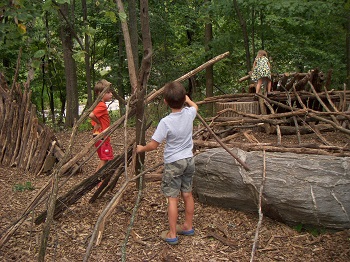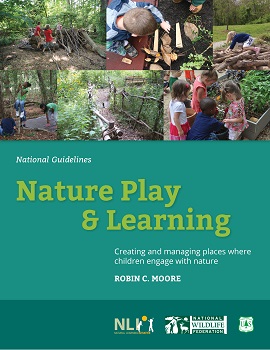The long-awaited national guidelines on the design, development and management of nature play areas written by Robin Moore, noted professor of landscape architecture and head of the Natural Learning Initiative (NLI) of North Carolina State University, have been released this week.
 The movement to connect kids to nature and the outdoors has surged in recent years. Inspired by seminal thinkers such as Richard Louv in his ground-breaking book, “The Last Child in the Woods,” parents, educators, and parks and recreation professionals have seen the need to allow kids to have unstructured free-play time in nature. Sending kids off to play in the woods, however, may not be feasible or realistic, but providing safe, managed, natural play and learning places is an ideal solution for parks, schools and neighborhoods.
The movement to connect kids to nature and the outdoors has surged in recent years. Inspired by seminal thinkers such as Richard Louv in his ground-breaking book, “The Last Child in the Woods,” parents, educators, and parks and recreation professionals have seen the need to allow kids to have unstructured free-play time in nature. Sending kids off to play in the woods, however, may not be feasible or realistic, but providing safe, managed, natural play and learning places is an ideal solution for parks, schools and neighborhoods.
But how do you provide safe natural play places?
This is the question that co-leaders Robin Moore and Allen Cooper of the National Wildlife Federation along with a blue-ribbon steering committee, including NRPA, tackled in developing the new guidelines, Nature Play & Learning Places: Creating and Managing Places Where Children Engage with Nature.
Traditional playgrounds have been great places for kids to play, and considerable thought and care goes into the design of safe, durable and attractive play equipment. But parents and parks leaders want more. They want a better way to allow unstructured play in ways that help kids make a true connection with the natural world, but the design and development of such areas presents daunting obstacles.
What is the right area to choose?
What kind of “natural” play structures are safe?
What are the hazards and risks in developing such nature play areas?
How do you maintain and care for natural play areas?
All these questions and more are answered in the definitive new guidelines. The 192-page illustrated manual is available for free download, and it provides not only design principles and management suggestions, but many examples of quality nature play places.
Park and recreation managers, park planners, landscape architects, environmental educators and many others now have a comprehensive set of well-thought out guidelines to guide design, development and management of nature play areas. A number of park and recreation agencies may have been reluctant to begin development of nature play areas because of concerns regarding hazard, risk, and liability. These issues are treated thoroughly in the guidelines. Many other aspects of design, development and management are covered extensively.
NRPA members will see many areas of concern and priorities of parks and recreation reflected in the guidelines. A number of NRPA members and staff participated in their development and served on the steering committee and several technical advisory committees. The scope of the guidelines is more fully examined in the September 2014 issue of Parks & Recreation Magazine.
These guidelines will be invaluable to the park and recreation profession, and will give park agencies new resources to develop their own nature play places with confidence.
If you are responsible for developing and managing play areas, connecting kids to nature and the outdoors, or just if you have a general interest in innovative new strategies for play, you will want to download and check out the new guidelines.
How do you think the new natural play places guidelines will shape the future of play for children? Share in the comments below or tweet us @NRPA_News.
Richard J. Dolesh is NRPA's vice president for conservation and parks.

